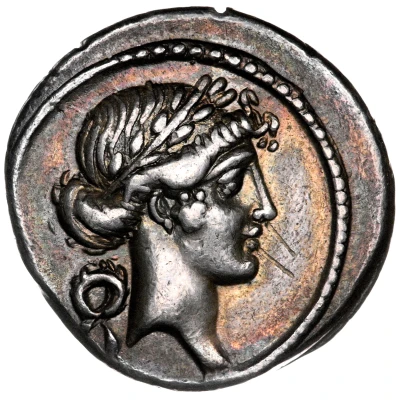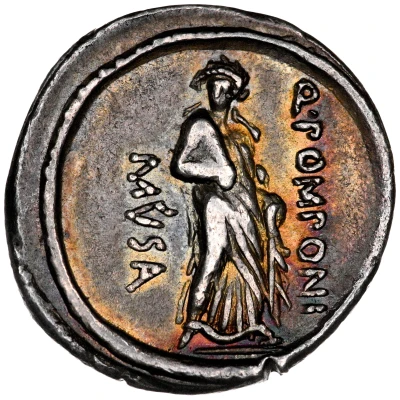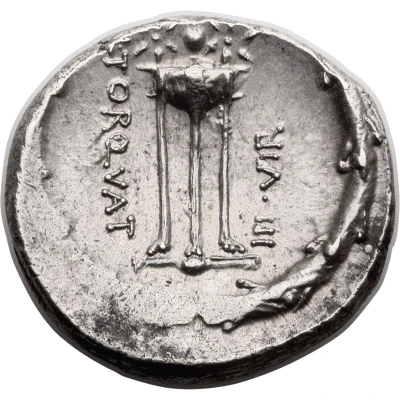


© Heritage Auctions
Denarius Pomponia: Quintus Pomponius Musa; Q•POMPONI MVSA; Polyhymnia 66 BC
66 BC year| Silver | 3.78 g | 18 mm |
| Issuer | Rome › Roman Republic (509 BC - 27 BC) |
|---|---|
| Period | Republic (509 BC - 27 BC) |
| Type | Standard circulation coin |
| Year | 66 BC |
| Value | Denarius (1) |
| Currency | Denarius of 16 Asses (141 – 27 BC) |
| Composition | Silver |
| Weight | 3.78 g |
| Diameter | 18 mm |
| Shape | Round (irregular) |
| Technique | Hammered |
| Orientation | Variable alignment ↺ |
| Demonetized | Yes |
| Updated | 2024-10-06 |
| Numista | N#377125 |
|---|---|
| Rarity index | 100% |
Reverse
Polyhymnia, the Muse of Rhetoric Music, facing, wearing wreath. Border of dots.
Script: Latin
Lettering:
Q•POMPONI
MVSA
Translation: Quintus Pomponius Musa
Comment
The gens Pomponia was a plebeian family at Rome throughout the period of the Republic and into imperial times. The first of the gens to achieve prominence was Marcus Pomponius, tribune of the plebs in 449 BC; the first who obtained the consulship was Manius Pomponius Matho in 233 BC.The moneyer Quintus Pomponius Musa plays on his name here by striking a 10-coins as a serie related to the myth of the Muses: 9 coins representing the 9 Muses along with one coin representing Hercules. Hercules is known in Greece, and as represented on this coin, as Hercules Musarum or Hercules Musageta, meaning Hercules, leader of the Muses.
Interesting fact
The Denarius coin features the image of Polyhymnia, the muse of sacred poetry and hymnody, on its reverse side. This is notable because it's one of the earliest depictions of a muse on a Roman coin, and it highlights the importance of poetry and music in Roman culture during that time.
Price
| Date | Mintage | VG | F | VF | XF | AU | UNC |
|---|---|---|---|---|---|---|---|
| ND (-66) | - | - | - | - | - | - |
Values in the table are based on evaluations by sales realized on Internet platforms. They serve as an indication only for Denarius (Pomponia: Quintus Pomponius Musa; Q•POMPONI MVSA; Polyhymnia) (66 BC) coin.



